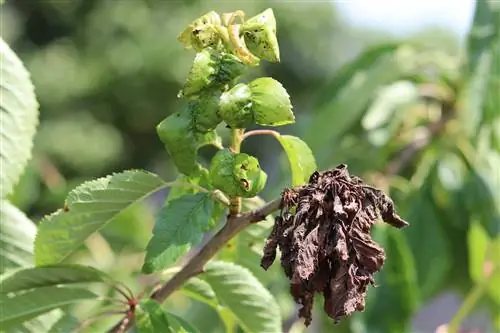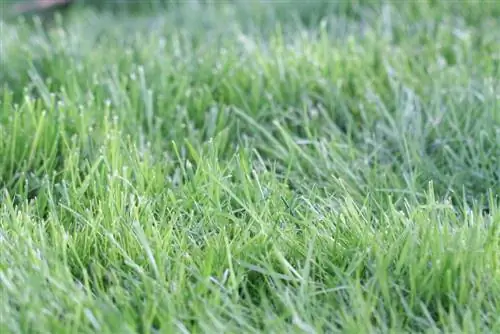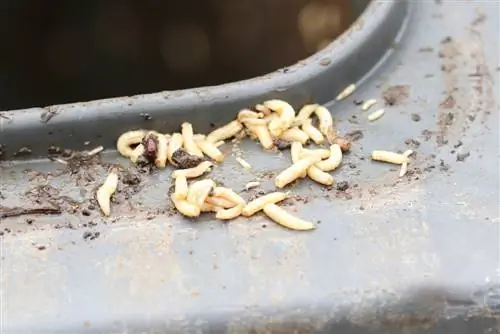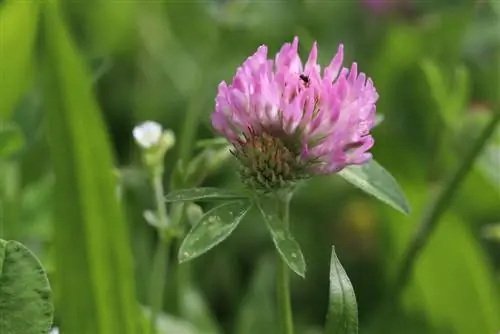- Author admin [email protected].
- Public 2023-12-17 03:39.
- Last modified 2025-01-24 12:45.
The so-called Monilia peak drought is a plant disease that is caused by a fungus called Monilia laxa and mostly affects stone and pome fruit trees. Although the disease can ultimately lead to the death of the affected plants, the real threat lies in the fact that the pathogen can survive even the harshest winters and is usually quickly transmitted to other plants.
Which plants are particularly threatened by Monilia?
Even though Monilia peak drought can affect pome fruit, it poses a significantly greater danger to stone fruits such as plums, apricots or sour cherries. The sour cherry species “Schattenmorelle” is considered particularly endangered. Although it should be noted that not only fruit trees, but also various ornamental plants, such as almond trees, can suffer from peak drought.
Properly prevent Monilia diseases
When planting new plants, it is advisable to choose plants that are as resistant as possible. In the case of sour cherries, these would include the varieties “Morellenfeuer”, “Gerama”, “Safir” and “Morina” as well as “Carnelian”, which are considered to be particularly resistant. In addition to the variety, the location is also very important. If possible, this should be sunny, warm and free of waterlogging. In addition, mixed cultures can reduce the risk of disease and its spread. In addition, potentially endangered tree species should be thinned out regularly. The use of special strengthening agents that make plants more resilient can also be recommended.
Depending on the weather, preventative spraying with fungicides can be useful. The same applies in the event of increased risk. For example, if trees in the immediate vicinity are already affected by Monilia peak drought. Before using fungicides or other pesticides, you should definitely contact the Federal Office of Consumer Protection to find out about their approval and whether they are safe for people and nature. In addition, it is incredibly important to regularly check your fruit trees for typical symptoms.
Resistant sour cherry varieties at a glance:
- ‘Morellenfeuer’
- ‘Gerama’
- ‘Safir’
- ‘Morina’
- ‘Carnelian’
Pattern and disease progression of peak drought
The pathogen Monilia laxa spreads mainly in spring through wind, rain and insects. As soon as it hits flowers, it gets into the fruit wood. It should be noted that the flowers don't even have to be fully open. Once in the wood, the fungus or pathogen secretes toxins that initially cause the flowers to wilt. It should be noted that persistent rain and extended flowering times due to temperatures promote infection, which is why particular attention should be paid to the first symptoms of the disease during a cold, wet spring at the latest. In addition to the wilted flowers, these symptoms include the wilting of the shoot tips and a pale green coloring of the leaves, which gradually hang limply from the infected branch before they wither completely. The affected branches and twigs then begin to dry out. In addition, a so-called rubber flow can form during the transition from diseased to he althy wood. The dried parts of the plant (flowers, leaves, shoots and branches) usually remain attached to the diseased tree. Nevertheless, the soil should be searched for fallen plant parts, as the pathogen can overwinter in these and in the parts of the plant remaining on the tree and could thereby promote rapid spread next spring.
Fighting peak drought
As soon as a tree shows the first symptoms of disease, affected areas should be removed immediately. To do this, cut or saw 15 to 30 cm into the he althy wood in the direction of the trunk. It is important to proceed very carefully so that, if possible, no fungal spores get into the air, otherwise they could be carried by the wind and attack other plants in the area. Then the cut surfaces should be sealed with tree wax. The clippings must be collected without leaving any residue and should ideally be burned. Alternatively, it can be disposed of with residual waste or buried deep away from endangered plants. Some gardeners are of the opinion that the infected clippings can be safely composted. However, this is not recommended, as Monilia laxa spores are so resilient that they can even survive for several years without any problems and could therefore infect other plants when distributed through the compost in the garden. However, if you still throw the clippings onto the compost heap or put them in a composter, they should be placed at least in the middle under several layers of other garden waste so that they are exposed to the composting process for as long as possible and there is a chance that the pathogens will be killed by the resulting heat become.
Due to the enormous risk of a new outbreak of the disease and the unforeseeably serious consequences that it could ultimately have in the entire garden, we must once again expressly advise against composting infected plant parts. It is also incredibly important to thoroughly clean the garden tools that were used to prune diseased trees after work, as spores of the pathogen could adhere to them, which would increase the risk of spreading if they were used again.
The Monilia fruit rot
Monilia fruit rot is a disease very similar to Monilia tip drought, which at least laypeople tend to think of as one and the same disease. In contrast to peak drought, fruit rot is not caused by Monilia laxa, but by a closely related fungus called Monilia fructigena. With regard to the preventative measures to be taken and measures to contain the spread and disposal of diseased plant parts, essentially comparable basic rules apply.
What you should know about the Monilia peak drought in brief
Monilia is a genus of fungi, a plant pest that mainly attacks fruit trees. There are different species that are often difficult to distinguish from one another. Monilia can appear as fruit rot and/or tip drought, usually immediately after flowering. Commonly affected:
- Apple,
- Pear,
- Sweet and sour cherries,
- but also plum
- and almond trees
It is particularly unfortunate that the pathogen can overwinter in rotten fruit on the tree, in infected branches and on the ground. However, there are now resistant fruit trees. These can be discounted when buying new! The coming infestation can usually be recognized on forsythia and almond trees. That's why they're called indicator plants. New shoots wilt, this is how you can recognize the fungus.
Fruit rot
- only affects injured fruits
- Rot often begins at feeding sites or wounds
- the fungus grows through the entire fruit
- It is characterized by white fruiting bodies on the rotten fruit, which is approximately coffee brown in color
- Spots are arranged in concentric circles - fruits dry up but often get stuck (fruit mummies)
Countermeasures
- Be sure to remove infected fruits to prevent further spread and transmission
- Cut branches back to he althy wood!
- Destroy waste - not on compost!
peak drought
- The pathogen penetrates the plant through the flowers in wet weather
- occurs particularly frequently after cool, wet springs
- affects especially sour cherries and especially the popular morello cherries, but also sweet cherries, apples, apricots and peaches
- causes the shoot tips to die off
- A rubber flow can occur at the transition point between infected and he althy wood
Countermeasures
- All affected shoots must be cut back to 15 cm into the he althy wood!
- It is best to seal the wounds with tree wax to prevent new pathogens from penetrating!
Prevention
- It's good to pay attention to resistant varieties when buying
- The right location is important - it should be sunny and airy so that any moisture can dry off easily
- also a good cut promotes quick drying and hinders the spread of the fungus
- Plant strengtheners have an infestation-reducing effect (pay attention to natural products!)
Plant protection products
- If prevention has not been successful, pesticides must be used!
- Recommended varieties are: “Duaxo Universal Pilz-frei” from Compo, “Pilzfrei Ectivo” from Scotts Celaflor and “Fruit-Mushroom-Free Teldor” from Bayer.
- It's a good idea to call the plant protection office in your own state and ask about suitable remedies!
- Only products that are approved for combating Manilia laxa or Manilia fructigena in home or allotment gardens may be used!
- The right time of application is important!
- It is best to spray Manilia laxa several times during flowering!





